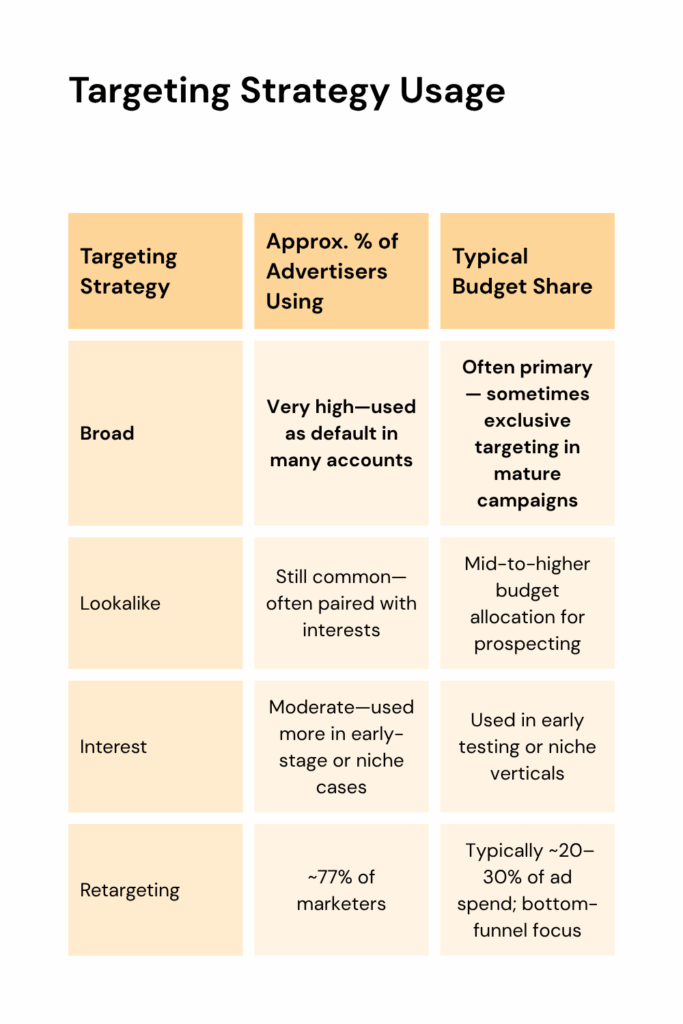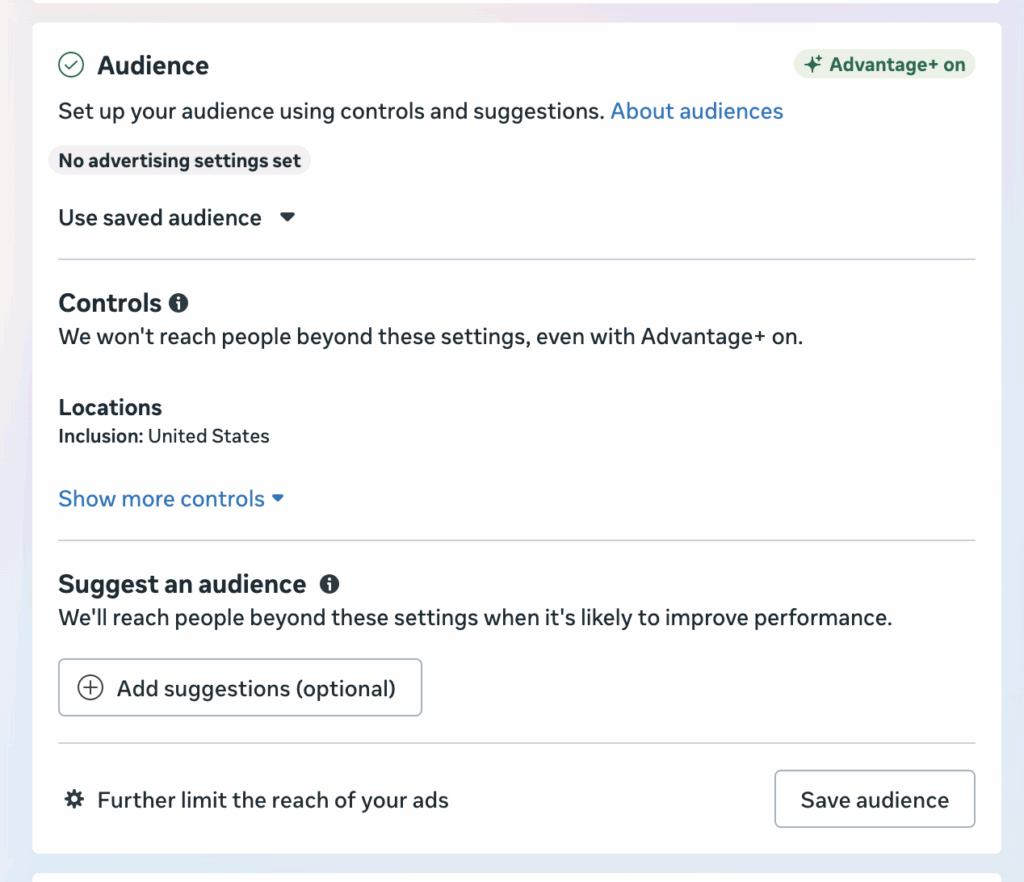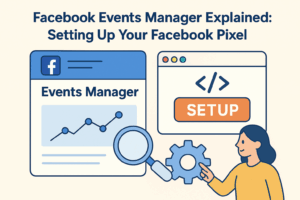- Understanding All Targeting Strategies: What Are Your Options?
- Broad Targeting vs. Lookalike Audiences: What's the Difference?
- How to Choose the Right Targeting Strategy
- Why Broad Targeting Became the Default
- When Broad Targeting Fails
- How to Enable Broad Targeting
- What Meta Really Wants: Broad Targeting and Advantage+
- Final Thoughts: Don’t Blindly Go Broad
If you’ve run Meta ads lately, chances are you’ve heard the advice: “Just go broad.” It’s everywhere—from Facebook reps to LinkedIn posts to YouTube gurus. Broad targeting is often presented as a one-size-fits-all solution that simplifies campaign setup and taps into Meta’s powerful algorithms. But is it always the best choice?
The truth is more nuanced. While broad targeting can drive results, it’s not a silver bullet—and it doesn’t work for every brand, campaign, or objective. In this guide, we’ll break down all the targeting strategies available on Meta, when to use each, and why broad targeting might not be the best fit for your goals.
Understanding All Targeting Strategies: What Are Your Options?
Before deciding whether to go broad or narrow, you need to understand the full range of targeting options on Meta.
Broad Targeting
Broad targeting means you’re relying entirely on Meta’s algorithm to find the right people based on your campaign objective. You set age, location, and sometimes gender, but you leave everything else up to the system. It works best when:
- You have strong conversion signals (e.g., Pixel, API, app events)
- Your budget is large enough for the algorithm to explore
- You’re optimizing for bottom-funnel outcomes (like purchases)
Interest Targeting
With interest targeting, you handpick categories that reflect user behaviors or preferences—like “vegan food,” “travel,” or “home improvement.” It gives you some control, especially if you’re testing new audiences or launching a new product.
Lookalike Audiences
Lookalikes let you expand your reach by targeting people who behave similarly to your existing customers or leads. They’re often used to scale success and maintain efficiency—especially when paired with high-quality seed lists and retention events.
Retargeting
Retargeting reaches people who have interacted with your brand—visited your site, added to cart, engaged with content, or started registration. It’s typically a high-ROAS, low-scale tactic that works well at the bottom of the funnel.

Broad Targeting vs. Lookalike Audiences: What’s the Difference?
At first glance, broad targeting and lookalike audiences can seem similar. They both rely on Meta’s algorithm to find the right people. But the way they work—and when to use them—are very different.
Broad targeting is completely open-ended. You don’t provide any behavioral or demographic signals other than basic parameters like age, location, or gender. Meta’s system decides who sees your ad based solely on your campaign objective and how users behave in real-time. It’s a high-risk, high-reward approach. When it works, it works brilliantly—but it requires clean, high-volume conversion data and a decent-sized budget to let the algorithm find patterns.
Lookalike audiences, on the other hand, are more guided. You start by feeding Meta a “seed audience”—a list of people who’ve already taken a valuable action, such as making a purchase, submitting a lead form, or subscribing to your service. Meta then finds users who behave similarly to those in your seed list. Because the system is working off proven behavioral data, it doesn’t need as much exploration time as broad does.
So, when should you use one over the other?
If you’re just starting out or don’t have strong pixel or Conversion API signals, lookalikes are a safer bet. They give the algorithm a head start and tend to perform well out of the gate, especially if your source audience is large and high-quality.
Broad targeting, on the other hand, is better suited for scaling once you’ve matured your tracking setup and proven your funnel. It thrives when paired with purchase optimization and Campaign Budget Optimization (CBO), particularly when your pixel is feeding consistent conversion events.
In some cases, the smartest strategy is to run both in parallel. Use lookalikes to maintain predictable performance, while testing broad targeting to unlock scale. Let Meta do what it does best—but only once you’ve given it the right signals to work with.
How to Choose the Right Targeting Strategy
There’s no one-size-fits-all targeting method in Meta ads. The right strategy depends on what you’re promoting, how much data you’ve gathered, and how Meta’s algorithm is likely to interpret that data.
Here’s a better way to approach it:
Start with the product or offer.
Is it niche or broad? Does it appeal to a very specific demographic or a general one? If you’re selling a specialized B2B software product, going broad probably won’t work. But if you’re advertising a mass-market consumer item—like skincare or apparel—broad might be exactly what you need.
Consider how much Meta knows about your conversions.
Do you have a well-trained pixel and consistent purchase data? If yes, you can likely trust Meta to optimize against broad audiences. But if you’re just getting started, and Meta hasn’t seen enough quality conversions, you’re better off guiding it with interest or lookalike targeting.
Match targeting to campaign objective.
If you’re running top-of-funnel campaigns (like brand awareness or engagement), interest targeting or even broader affinity groups can help introduce people to your brand. For mid-funnel (like lead gen or add to cart), lookalikes based on high-intent behavior work well. For bottom-of-funnel (like purchases), broad targeting can shine—but only if Meta has enough signal to know what a qualified purchase looks like.
In short:
- Use interest targeting when you need control or want to test messaging to specific segments.
- Use lookalikes when you have quality source data and want predictable scaling.
- Use broad when you have strong conversion signals and want the algorithm to take over.
Your targeting strategy should evolve with your account maturity. What works for a brand-new ad account with no pixel history won’t work for a seasoned brand doing $100k/month in ad spend. Start with control, then give more freedom to the algorithm as your data improves.
Why Broad Targeting Became the Default
Meta has invested heavily in automation—across placements, creative, bidding, and targeting. Broad targeting is the natural extension of this trend. Here’s why so many advertisers lean on it:
- Better delivery performance at scale: Broad enables Meta’s AI to explore more combinations and optimize towards in-platform behaviors like purchases or installs.
- Simpler setup: You don’t need to create layered targeting stacks or segment your audiences.
- Works well with CBO (Campaign Budget Optimization): When paired with CBO and sales objective, broad gives the algorithm more flexibility to find the best conversions.
When it works, broad targeting feels like magic: lower CPAs, faster learning, and fewer headaches. But that’s not always the case.
When Broad Targeting Fails
There are real scenarios where broad targeting underperforms—and can waste valuable budget.
- Your pixel lacks high-quality events. Meta can’t optimize for conversions it can’t see. If you’re missing Pixel or Conversion API setups, don’t expect broad targeting to deliver.
- You’re running a niche offer. If you sell a product tailored to a narrow demographic, Meta may struggle to find your ideal buyer in the vast sea of users.
- Low budget campaigns. Without enough budget, Meta’s algorithm doesn’t have the space to explore and optimize. Broad becomes a guessing game.
Put simply, broad targeting needs data. Without it, the algorithm’s “smartness” is limited—and you’ll get better results with guided targeting.
How to Enable Broad Targeting
If you’re ready to test broad, here’s how to set it up for success:
- Choose the right objective. Sales, leads, or app promotion objectives work best.

- Use high-quality conversion events. Optimize for bottom-funnel events (purchase, complete registration).
- Avoid layering restrictions. Remove interests, behaviors, and detailed demographics. Keep age, location, and language only.

- Pair with CBO. Use Campaign Budget Optimization with min/max ad set floors if needed for control.
- Let it exit the learning phase. Allocate enough budget and time to allow the algorithm to stabilize.
Pro tip: If you need some control, try setting min and max spends at the ad set level within CBO. This gives you the best of both worlds—algorithmic flexibility and guardrails.
What Meta Really Wants: Broad Targeting and Advantage+
Meta is increasingly pushing advertisers toward Advantage+ campaigns—a product that automates virtually everything, including audience selection.
With Advantage+ shopping or app campaigns:
- Targeting is fully automated (only geography, language, and age remain editable).
- Budget flows dynamically between ad sets (via CBO) to optimize performance.
- Creative, placements, and even conversion paths are dynamically selected.
Why? Because broad targeting helps Meta gather more signals, test more combinations, and ultimately deliver better ad performance at scale. But here’s the catch: Meta doesn’t optimize for your internal sales quality—only for purchase behavior. That means not all conversions are created equal.
Final Thoughts: Don’t Blindly Go Broad
Broad targeting is powerful—but only when used under the right conditions. It’s not the answer for every campaign, every advertiser, or every objective.
If you’re in a growth phase, have clean conversion signals, and want to scale—go broad. But if you’re launching something new, testing a niche product, or working with limited budget and data, a more guided approach may perform better.
Targeting isn’t about picking the “best” tactic—it’s about choosing the strategy that aligns with your data maturity, business stage, and campaign objective.
TL;DR:
- Broad targeting works best with strong signals and large budgets.
- Layered targeting (interest, lookalike, retargeting) still plays a role—especially in early-stage campaigns.
- Meta’s algorithm is powerful, but it’s not psychic. Feed it the right data.
- Combine broad targeting with CBO and optimized sales events for maximum impact.
- Advantage+ is Meta’s future—but it may not reflect your internal definition of success.



